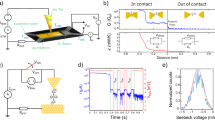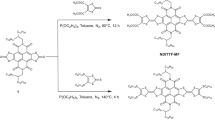Abstract
Molecular junctions hold significant promise for efficient and high-power-output thermoelectric energy conversion1,2,3. Recent experiments have probed the thermoelectric properties of molecular junctions4,5,6,7. However, electrostatic control of thermoelectric properties via a gate electrode has not been possible due to technical challenges in creating temperature differentials in three-terminal devices. Here, we show that extremely large temperature gradients (exceeding 1 × 109K m−1) can be established in nanoscale gaps bridged by molecules, while simultaneously controlling their electronic structure via a gate electrode. Using this platform, we study prototypical Au–biphenyl-4,4′-dithiol–Au and Au–fullerene–Au junctions to demonstrate that the Seebeck coefficient and the electrical conductance of molecular junctions can be simultaneously increased by electrostatic control. Moreover, from our studies of fullerene junctions, we show that thermoelectric properties can be significantly enhanced when the dominant transport orbital is located close to the chemical potential (Fermi level) of the electrodes. These results illustrate the intimate relationship between the thermoelectric properties and charge transmission characteristics of molecular junctions and should enable systematic exploration of the recent computational predictions1,2,3 that promise extremely efficient thermoelectric energy conversion in molecular junctions.
This is a preview of subscription content, access via your institution
Access options
Subscribe to this journal
Receive 12 print issues and online access
$259.00 per year
only $21.58 per issue
Buy this article
- Purchase on Springer Link
- Instant access to full article PDF
Prices may be subject to local taxes which are calculated during checkout



Similar content being viewed by others
References
Karlström, O., Linke, H., Karlström, G. & Wacker, A. Increasing thermoelectric performance using coherent transport. Phys. Rev. B 84, 113415 (2011).
Finch, C. M., García-Suárez, V. M. & Lambert, C. J. Giant thermopower and figure of merit in single-molecule devices. Phys. Rev. B 79, 033405 (2009).
Bergfield, J. P., Solis, M. A. & Stafford, C. A. Giant thermoelectric effect from transmission supernodes. ACS Nano 4, 5314–5320 (2010).
Reddy, P., Jang, S. Y., Segalman, R. A. & Majumdar, A. Thermoelectricity in molecular junctions. Science 315, 1568–1571 (2007).
Widawsky, J. R., Darancet, P., Neaton, J. B. & Venkataraman, L. Simultaneous determination of conductance and thermopower of single molecule junctions. Nano Lett. 12, 354–358 (2012).
Evangeli, C. et al. Engineering the thermopower of C60 molecular junctions. Nano Lett. 13, 2141–2145 (2013).
Guo, S. Y., Zhou, G. & Tao, N. J. Single molecule conductance, thermopower, and transition voltage. Nano Lett. 13, 4326–4332 (2013).
Lee, W. et al. Heat dissipation in atomic-scale junctions. Nature 498, 209–212 (2013).
Choi, S. H., Kim, B. & Frisbie, C. D. Electrical resistance of long conjugated molecular wires. Science 320, 1482–1486 (2008).
Xu, B. Q. & Tao, N. J. J. Measurement of single-molecule resistance by repeated formation of molecular junctions. Science 301, 1221–1223 (2003).
Venkataraman, L., Klare, J. E., Nuckolls, C., Hybertsen, M. S. & Steigerwald, M. L. Dependence of single-molecule junction conductance on molecular conformation. Nature 442, 904–907 (2006).
Liang, W. J., Shores, M. P., Bockrath, M., Long, J. R. & Park, H. Kondo resonance in a single-molecule transistor. Nature 417, 725–729 (2002).
Song, H. et al. Observation of molecular orbital gating. Nature 462, 1039–1043 (2009).
Yu, L. H. & Natelson, D. The Kondo effect in C60 single-molecule transistors. Nano Lett. 4, 79–83 (2004).
Perrin, M. L. et al. Large tunable image-charge effects in single-molecule junctions. Nature Nanotech. 8, 282–287 (2013).
Cuevas, J. C. & Scheer, E. Molecular Electronics: An Introduction to Theory and Experiment (World Scientific, 2010).
Bergfield, J. P., Solomon, G. C., Stafford, C. A. & Ratner, M. A. Novel quantum interference effects in transport through molecular radicals. Nano Lett. 11, 2759–2764 (2011).
Nitzan, A. & Ratner, M. A. Electron transport in molecular wire junctions. Science 300, 1384–1389 (2003).
Paulsson, M. & Datta, S. Thermoelectric effect in molecular electronics. Phys. Rev. B 67, 241403(R) (2003).
Ke, S. H., Yang, M., Curtarolo, S. & Baranger, H. U. Thermopower of molecular junctions: an ab initio study. Nano Lett. 9, 1011–1014 (2009).
Kim, K., Jeong, W., Lee, W. & Reddy, P. Ultra-high vacuum scanning thermal microscopy for nanometer resolution quantitative thermometry. ACS Nano 6, 4248–4257 (2012).
Jeong, W., Kim, K., Kim, Y., Lee, W. & Reddy, P. Characterizaion of nanoscale temperature fields during electromigration of nanowires. Sci. Rep. 4, 4975 (2014).
Bürkle, M. et al. Conduction mechanisms in biphenyl-dithiol single-molecule junctions. Phys. Rev. B 85, 075417 (2012).
Bilan, S., Zotti, L. A. & Cuevas, J. C. Theoretical study of the charge transport through C60-based single-molecule junctions. Phys. Rev. B 85, 205403 (2012).
Géranton, G., Seiler, C., Bagrets, A., Venkataraman, L. & Evers, F. Transport properties of individual C60-molecules. J. Chem. Phys. 139, 234701 (2013).
Ulstrup, S., Frederiksen, T. & Brandbyge, M. Nonequilibrium electron-vibration coupling and conductance fluctuations in a C60 junction. Phys. Rev. B 86, 245417 (2012).
Xiang, D. et al. Three-terminal single-molecule junctions formed by mechanically controllable break junctions with side gating. Nano Lett. 13, 2809–2813 (2013).
Kim, Y., Pietsch, T., Erbe, A., Belzig, W. & Scheer, E. Benzenedithiol: a broad-range single-channel molecular conductor. Nano Lett. 11, 3734–3738 (2011).
Kim, Y. et al. Charge transport in azobenzene-based single-molecule junctions. Phys. Rev. Lett. 109, 226801 (2012).
Baheti, K. et al. Probing the chemistry of molecular heterojunctions using thermoelectricity. Nano Lett. 8, 715–719 (2008).
Tan, A. et al. Length dependence of frontier orbital alignment in aromatic molecular junctions. Appl. Phys. Lett. 101, 243107 (2012).
Yee, S. K., Malen, J. A., Majumdar, A. & Segalman, R. A. Thermoelectricity in fullerene–metal heterojunctions. Nano Lett. 11, 4089–4094 (2011).
Acknowledgements
P.R. acknowledges support from the Office of Naval Research (award no. N00014-13-1-0320; nanofabrication of devices), the Department of Energy–Basic Energy Sciences (a grant from the Scanning Probe Microscopy Division, award no. DE-SC0004871; scanning thermal microscopy), the Air Force Office of Scientific Research (award no. FA9550-12-1-0058; instrumentation) and the University of Michigan–Ben Gurion University of the Negev Joint Research Collaboration (device modelling). All authors acknowledge the Lurie Nanofabrication Facility (LNF) for facilitating the nanofabrication of devices.
Author information
Authors and Affiliations
Contributions
The project was conceived by P.R. Thermopower gating and other electrical measurements were performed by Y.K. and W.J. Nanoscale thermal imaging was performed by K.K. and W.L. Finite-element thermal modelling was performed by W.J. EBJIHs were designed and nanofabricated by W.J., Y.K. and K.K. The manuscript was written by P.R., Y.K. and W.J., with comments and input from all authors.
Corresponding author
Ethics declarations
Competing interests
The authors declare no competing financial interests.
Supplementary information
Supplementary information
Supplementary Information (PDF 2756 kb)
Rights and permissions
About this article
Cite this article
Kim, Y., Jeong, W., Kim, K. et al. Electrostatic control of thermoelectricity in molecular junctions. Nature Nanotech 9, 881–885 (2014). https://doi.org/10.1038/nnano.2014.209
Received:
Accepted:
Published:
Issue Date:
DOI: https://doi.org/10.1038/nnano.2014.209
This article is cited by
-
Vacancy tuned thermoelectric properties and high spin filtering performance in graphene/silicene heterostructures
Scientific Reports (2021)
-
Complete mapping of the thermoelectric properties of a single molecule
Nature Nanotechnology (2021)
-
Side-group-mediated thermoelectric properties of anthracene single-molecule junction with anchoring groups
Scientific Reports (2021)
-
Thermoelectricity of near-resonant tunnel junctions and their relation to Carnot efficiency
Scientific Reports (2021)
-
Atomically defined angstrom-scale all-carbon junctions
Nature Communications (2019)



